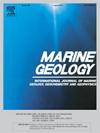Decoding intertidal oyster reef morphology: Insights from UAV photogrammetry and deep learning
IF 2.2
3区 地球科学
Q2 GEOSCIENCES, MULTIDISCIPLINARY
引用次数: 0
Abstract
Global coverage of oyster reefs has substantially declined due to environmental changes driven by climate change and human activities, severely impairing their ecological functions. Quantitative information on oyster reef morphology is crucial for developing restoration strategies and understanding the ecomorphodynamics of these reefs. This study focused on the Liyashan oyster reef conservation area in the intertidal zone of Haimen, Jiangsu, China. We utilized Unmanned Aerial Vehicle (UAV) photogrammetry to obtain RGB orthoimages and Digital Elevation Models (DEMs) with centimeter-level resolution and accuracy. By integrating UAV photogrammetry and Deep Learning techniques, we efficiently and accurately identified reef footprints and created pixel-level reef height maps. Based on the reef height data, we introduced the Volume Balance Index (VBI) to assess reef fragmentation (degree of pitting), where a lower VBI value indicates higher relative fragmentation. Quantitative results at the reef block scale demonstrate a significant negative correlation between reef size (area and height) and overall fragmentation, with a strong logarithmic relationship between reef height and VBI. Generally, less degraded reefs are primarily distributed in the eastern and southern parts of the region, a pattern potentially related to local hydrodynamic conditions. This study provides a cost-effective and efficient solution for monitoring intertidal oyster reefs and lays the foundation for further research on their ecomorphodynamics.
解码潮间带牡蛎礁形态:来自无人机摄影测量和深度学习的见解
由于气候变化和人类活动导致的环境变化,全球牡蛎礁覆盖率大幅下降,其生态功能严重受损。牡蛎礁形态的定量信息对于制定恢复策略和了解牡蛎礁的生态形态动力学至关重要。本研究以江苏海门潮间带黎鸭山牡蛎礁保护区为研究对象。我们利用无人机摄影测量技术获得了具有厘米级分辨率和精度的RGB正射影像和数字高程模型(dem)。通过结合无人机摄影测量和深度学习技术,我们高效准确地识别了珊瑚礁足迹,并创建了像素级的珊瑚礁高度图。基于礁体高度数据,我们引入了体积平衡指数(VBI)来评估礁体破碎度(点蚀程度),VBI值越低表明相对破碎度越高。在礁块尺度上的定量结果表明,礁块大小(面积和高度)与整体破碎度呈显著负相关,礁块高度与VBI呈强对数关系。一般来说,退化程度较低的珊瑚礁主要分布在该区域的东部和南部,这种模式可能与当地的水动力条件有关。本研究为潮间带牡蛎礁监测提供了一种经济高效的解决方案,为潮间带牡蛎礁生态形态动力学的进一步研究奠定了基础。
本文章由计算机程序翻译,如有差异,请以英文原文为准。
求助全文
约1分钟内获得全文
求助全文
来源期刊

Marine Geology
地学-地球科学综合
CiteScore
6.10
自引率
6.90%
发文量
175
审稿时长
21.9 weeks
期刊介绍:
Marine Geology is the premier international journal on marine geological processes in the broadest sense. We seek papers that are comprehensive, interdisciplinary and synthetic that will be lasting contributions to the field. Although most papers are based on regional studies, they must demonstrate new findings of international significance. We accept papers on subjects as diverse as seafloor hydrothermal systems, beach dynamics, early diagenesis, microbiological studies in sediments, palaeoclimate studies and geophysical studies of the seabed. We encourage papers that address emerging new fields, for example the influence of anthropogenic processes on coastal/marine geology and coastal/marine geoarchaeology. We insist that the papers are concerned with the marine realm and that they deal with geology: with rocks, sediments, and physical and chemical processes affecting them. Papers should address scientific hypotheses: highly descriptive data compilations or papers that deal only with marine management and risk assessment should be submitted to other journals. Papers on laboratory or modelling studies must demonstrate direct relevance to marine processes or deposits. The primary criteria for acceptance of papers is that the science is of high quality, novel, significant, and of broad international interest.
 求助内容:
求助内容: 应助结果提醒方式:
应助结果提醒方式:


